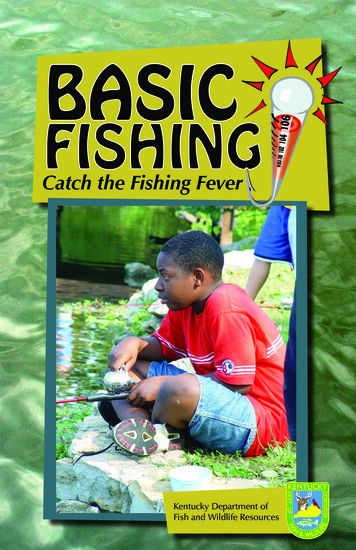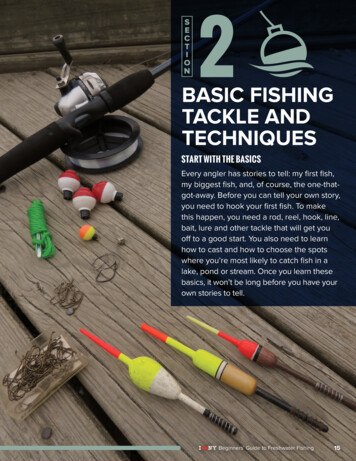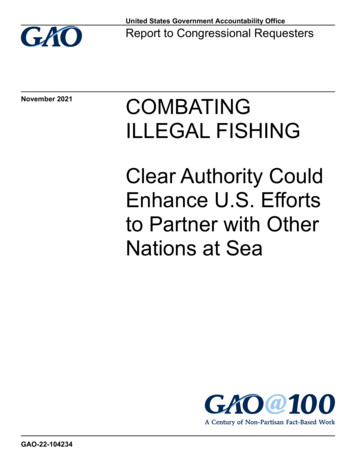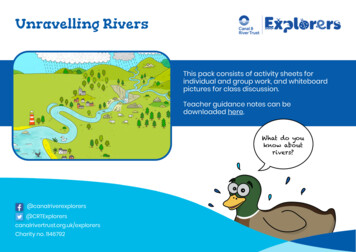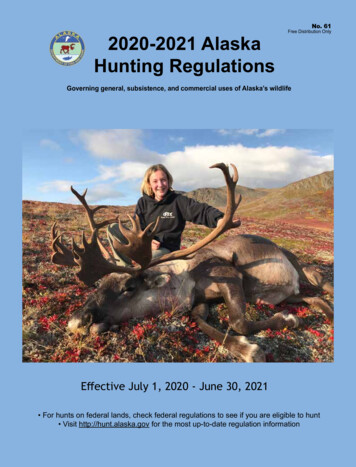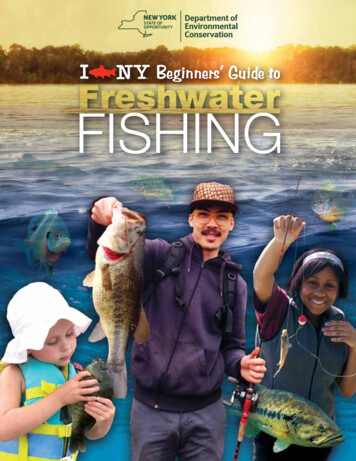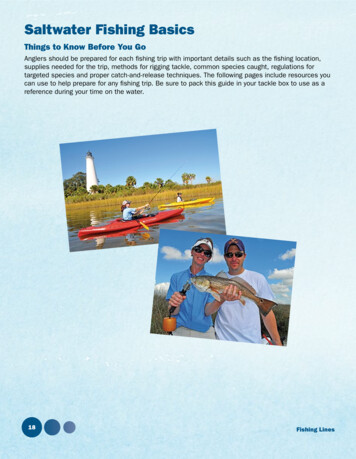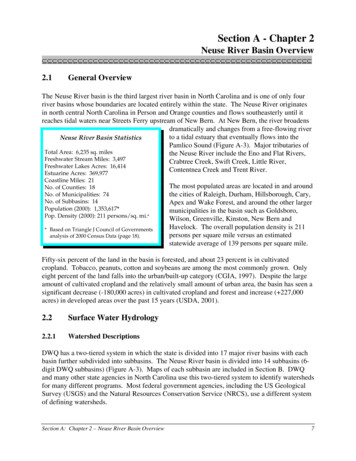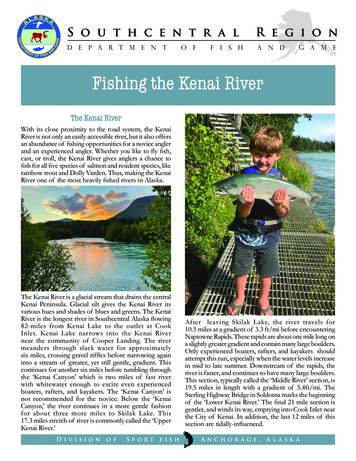
Transcription
S o u t h c e n t r a lR e g i o nDaep ar tmentofFishndGameFishing the Kenai RiverThe Kenai RiverWith its close proximity to the road system, the KenaiRiver is not only an easily accessible river, but it also offersan abundance of fishing opportunities for a novice anglerand an experienced angler. Whether you like to fly fish,cast, or troll, the Kenai River gives anglers a chance tofish for all five species of salmon and resident species, likerainbow trout and Dolly Varden. Thus, making the KenaiRiver one of the most heavily fished rivers in Alaska.The Kenai River is a glacial stream that drains the centralKenai Peninsula. Glacial silt gives the Kenai River itsvarious hues and shades of blues and greens. The KenaiRiver is the longest river in Southcentral Alaska flowing82-miles from Kenai Lake to the outlet at CookInlet. Kenai Lake narrows into the Kenai Rivernear the community of Cooper Landing. The rivermeanders through slack water for approximatelysix miles, crossing gravel riffles before narrowing againinto a stream of greater, yet still gentle, gradient. Thiscontinues for another six miles before tumbling throughthe ‘Kenai Canyon’ which is two miles of fast riverwith whitewater enough to excite even experiencedboaters, rafters, and kayakers. The ‘Kenai Canyon’ isnot recommended for the novice. Below the ‘KenaiCanyon,’ the river continues in a more gentle fashionfor about three more miles to Skilak Lake. This17.3 miles stretch of river is commonly called the ‘UpperKenai River.’DivisionofSportfishAfter leaving Skilak Lake, the river travels for10.5 miles at a gradient of 3.3 ft/mi before encounteringNaptowne Rapids. These rapids are about one mile long ona slightly greater gradient and contain many large boulders.Only experienced boaters, rafters, and kayakers shouldattempt this run, especially when the water levels increasein mid to late summer. Downstream of the rapids, theriver is faster, and continues to have many large boulders.This section, typically called the ‘Middle River’ section, is19.5 miles in length with a gradient of 5.4ft/mi. TheSterling Highway Bridge in Soldotna marks the beginningof the ‘Lower Kenai River.’ The final 21 mile section isgentler, and winds its way, emptying into Cook Inlet nearthe City of Kenai. In addition, the last 12 miles of thissection are tidally-influenced.Anchor age,Al a sk a
Upper Kenai River: From Kenai Lake downstream to Skilak LakeThere are about 40 species of fish in the Kenai River.There are resident fish such as rainbow trout and DollyVarden which spend their entire lifecycle in the KenaiRiver; anadromous fish, such as Pacific salmon andsea-run Dolly Varden which spend a portion of theirlifecycle in the river and the other portion of their lives insaltwater; and fish such as flounder or that are commonto the intertidal area, which is a mixture of both freshand salt water.Fisheries (BOF). Enforcement of fishing regulationsis primarily the responsibility of the Alaska WildlifeTroopers. ADF&G Soldotna office is the managementoffice for this area.Every year ADF&G releases four sport fishing regulationsbooklets for the Northern, Southcentral, Southeast, andSouthwest areas. Sport fishing regulations specific tothe Kenai River area such as bag and possession limits,seasons, tackle, or bait limits can be found in the currentSouthcentral Alaska Sport Fishing Regulations Summarybooklet.These booklets are free of charge and are available atADF&G offices, wherever sport fishing licenses are sold,and online at www.adfg.alaska.gov under the Regulationstab. Before you cast out your line, make sure you read allthe regulations for the waters you are fishing. Don’t forgetto check for advisory announcements and emergencyorders on the ADF&G website at www.adfg.alaska.gov.ADF&G may issue an advisory announcement andemergency order to open, liberalize, close, or restrict anyfishery at any time due to biological needs. In the event anadvisory announcement and emergency order is issued,ADF&G attempts to release the documents a minimumof 24 to 48 hours before it becomes effective. Anglers canfind advisory announcements and emergency orders onthe ADF&G website under the Sport Fishing tab. Selectthe Fishing Information link and then the EmergencyOrders and News Releases tab. Once there, anglers canselect the region and management area they intend to fish.Sport Fishing RegulationsThe Alaska Department of Fish and Game (ADF&G),Division of Sport Fish (DSF) is charged with themanagement of Alaska’s sport fisheries under thesustainable yield principle, through regulations andmanagement plans adopted by the Alaska Board ofDuring the summer ADF&G posts weekly in-seasonfishing reports online. Anglers can find these under theFishing Reports tab under the Fishing Information tab.ADF&G staff records these in-season fishing reportson the Soldotna sport fishing hotline at (907) 262-2737.Anglers can also subscribe to receive the notifications viatheir email. Updates are also posted on the ADF&G Sport Fishing Southcentral Alaska Facebook page. If youhave any questions, please contact the Soldotna ADF&Goffice at (907) 262-9368.
Chinook Salmon Run TimingThe Kenai River supports two distinct Chinook salmonruns; an early-run and a late-run. The early-run usuallyenters the river in mid-May. The early-run fishing peaksin mid-June, and is over by the end of June. The early-runfish primarily head for smaller Kenai River tributaries tospawn. Late-run Chinook salmon enter the river in earlyJuly, with the best fishing found from mid- to late Julyand are generally considered mainstem spawning fish.Chinook SalmonThe world’s record rod and reel Chinook or king salmonwas caught in 1985 from the Kenai River, and weighed97 lbs. 4 oz. However, not all Kenai River Chinooksalmon are that large. Most Kenai Peninsula king salmonspend one year in freshwater, then migrate to sea whenthey are about four inches long. The length of time insaltwater, how much food they find, and the geneticcomposition of the fish all help to determine their finalsize.No one knows why Chinook salmon return at differentages. Some Chinook salmon return after only one year inthe ocean. These fish weigh only a few pounds, and arealmost always fertile males. Others return after two yearsand weigh 10 to 20 pounds and a majority of these fishare males. The majority of Southcentral Chinook salmonweigh 25 to 60 pounds and some return after five yearsat sea. Chinook salmon of the same age will also vary insize from stream to stream, perhaps due to genetics. A“four-ocean” fish in lower Kenai Peninsula streams willrarely grow to (and only a few exceed) 40 pounds. Inthe Kenai River, though, a 50-pound “four-ocean” fishis fairly common. The world record fish caught in 1985spent one year in freshwater, five years in saltwater andreturned in its seventh year of life.Chinook Salmon Fishery ManagementBoth Chinook salmon runs are intensively andconservatively managed by the DSF under managementplans outlined by the Alaska BOF. Special restrictionson bait, tackle, and harvestable sizes apply to both runs.Please review the current Southcentral Alaska advisoryannouncements and emergency orders for these waterson the ADF&G website at www.adfg.alaska.gov beforeyour next fishing adventure.The DSF uses the best technologies and most accuratemethods available to estimate both the run strengthand the spawning escapement of Kenai River Chinooksalmon. The DSF primarily relies on two methods toestimate run strength: 1) an in-river sonar program, and2) an in-season creel survey/census which consists ofADF&G Fishery Technicians interviewing anglers onLower Kenai River: From Skilak Lake downstream to the mouth
the Kenai River. The DSF then estimates the spawningescapements - how many fish have escaped harvest - bysubtracting the creel census figure from the number ofChinook salmon going through the sonar counter. Inorder to ensure accuracy, additional measurements ofrun strength such as harvest in the commercial fishery,offshore test fishing, test net catches in the river, andangler success rates, among other methods are also used.Both of the Chinook salmon runs, as well as, the latesockeye salmon run are measured by state-of-the-art sonarequipment. The Chinook salmon sonar site is operated bythe Division of Sport Fish and is located at river mile 14.The sockeye salmon sonar site is operated by the Divisionof Commercial Fisheries, and is located at river mile 19.5.Sonar (ARIS) is currently used at the river mile 14 site.Sampling on both banks is controlled by electronicshoused in a tent located on the left bank of the river (leftbank facing downstream). Data from the right bank aretransmitted wirelessly to the left bank tent. All data filesare then transported to the ADF&G office for processing.ADF&G assesses in season Chinook salmon abundancebased on daily estimates of large fish ( 34 inches fromsnout to tip of tail as measured by the sonar). Estimates offish size are generated by measuring the video-like images offish produced by ARIS. Post season estimates of all Chinooksalmon, regardless of size, are produced using river mile 9netting data and river mile 14 sonar counts.Because both sport and commercial fishing regulationspartly depend on how many fish are estimated to havepassed through the sonar beams, the proper operation ofthis expensive and highly sensitive equipment is criticalto the entire salmon fishing industry. Submerged sonarequipment will entangled your fishing gear, giant Chinooksalmon, or boat propeller. Obey the traffic signs near thesonar sites to avoid trouble.Sonar estimates are available on our website at www.adfg.alaska.gov, and click on “Fish Counts.” More informationabout the Chinook salmon sonar program can be found atwww.adfg.alaska.gov/index.cfm?adfg sonar.site&site 17.NORTHWarning BuoyWarning BuoyFixed Partial WeirrveRi-owFlTackle and Fishing MethodsThere are three types of fishing techniques that arepopular with Chinook salmon anglers. Each techniquestakes advantages of the fact that Chinook salmon traveldeep, through the center of the river channel. Shoreanglers are at a slight disadvantage when fishing for KenaiRiver Chinook salmon.Fishing from a boat allows anglers to drift with thecurrent, allowing the lure to bounce along the bottom atthe speed of the current. ‘Back bouncing’ is a very popularmethod. The boat is constantly under power and slowlybacked down the river. As the boat backs through a holeor drift, the angler bounces the lure along the bottom ofthe river. ‘Back trolling’ is another popular method, andinvolves the use of a plug of the flatfish variety, such asa Kwikfish. A planer is attached ahead of the lure to takethe lure to the bottom of the river. The boat is backeddown river under power.The most common rig for drifting and back bouncingis a large Spin-N-Glo with fresh or preserved salmoneggs (when permitted) and enough weight to get thelure to the bottom. Since the lure is moving quite rapidly,clearer water increases the efficiency of these techniques.Much depends on the skill of the boat operator, as well.Because there are a lot of boats on the Kenai River, wesuggest that the boat operator concentrate only on safeboat operation.The Kenai River Chinook salmon fishery is crowded, sobring along an ample supply of patience and courtesy.Know your boat and how to operate it. Be familiar withthe “rules of the river.” For example, the universal signalon the Kenai River of a “fish on” is a raised landingnet. Give those boats the widest berth possible. On theKenai River Sonar ProgramsKenai River, guided anglers are about twice as efficientas nonguided anglers. You can improve your chances byhiring a guide, especially if you are either a novice and/or you lack suitable equipment.Sockeye SalmonRun TimingAlthough, there are two sockeye or red salmon runs on theKenai River, the early-run sockeye salmon does not presentmuch opportunity for the Kenai River sport angler. It’s a
small run, and the fish are headed for the Russian Riverdrainage. Anglers can find more information about theRussian River fishery by picking up a copy of the Fishingthe Russian River” publication from ADF&G offices orfind it on the ADF&G Sport Fishing Brochures webpagehttp://www.adfg.alaska.gov/index.cfm?adfg utperform the popular streamers. Also popular are redhooks with a bit of yarn tied on them. Weights are usedto get the fly close to the bottom. The fly is casted out10 to 15 feet into the current at about a 45-degree angleupstream and allowed to “dead drift” with the currentuntil reaching its furthest downstream point. It is thenretrieved and the action repeated.The most productive fishing areas are pools immediatelydownstream of shallow riffles, and mainstem close toshore. Sockeye salmon tend to hold in these areas beforemigrating through the riffles. Since this species travelsclose to shore, most sockeye salmon fishing takes placefrom the bank. Inexperienced sockeye salmon anglersoften wade or cast too far out, not realizing the fish areoften swimming right behind them.Coho SalmonAlthough tradition holds that there are two coho or silversalmon runs in the Kenai River, there are actually severalperiods of in-migration. The earlier fish arrive in lateJuly, with more fish arriving early to mid-August throughearly October.The Kenai River late-run sockeye salmon enter the lowerKenai River in early July, peak in late July, and the rungenerally is finished by early to mid-August. Most fisharrive during the last two weeks of July. At the peak of agood run, it is not uncommon to see sonar estimates ofgreater than 20,000 fish per day. These fish are headedfor many tributary streams throughout the area, as wellas, the Russian River, the mainstem of the Upper KenaiRiver, and Kenai Lake to spawn.Sockeye Salmon Fishery ManagementBoth sockeye salmon runs are intensively managedby DSF and the Division of Commercial Fish undermanagement plans outlined by the Alaska BOF. Specialrestrictions on bait and tackle apply to both runs,including special sections of the Kenai River that arefly-fishing-only. Check the current Southcentral AlaskaSport Fishing Regulations Summary booklet before youhead out fishing for sockeye salmon on the Kenai River.Tackle and Fishing MethodsMost Kenai River sockeye salmon anglers use a streameror “Russian River Coho” fly, although some claim thatthe “Green Lantern,” “Comet,” or any shrimp pattern allMost anglers will boat to a favorite hole and anchor, ortie off to the bank. From the boat, they then fish freshor cured salmon roe (if permitted) on the bottom, or useMepps, Pixee, or Vibrax lures. Since coho salmon use theentire river to travel, there is more opportunity for anglersto access more banks areas that are productive for cohosalmon than there are for Chinook salmon. Many guidesoffer coho salmon charters for novice and/or thoseanglers who lack suitable equipment.Pink SalmonBecause of their two-year lifecycle, pink or humpy salmonnumbers are highest on even-numbered years. Young andnovice anglers favor pink salmon because of this species’large numbers and aggressiveness towards almost any lure.Pink salmon also offer an excellent challenge to anglerspreferring light tackle.Most Kenai River pink salmon are taken downstreamfrom the Sterling Highway Bridge in Soldotna. One good
Summary booklet carefully before fishing for rainbowtrout and steelhead trout on the Kenai River.place to try is at Cunningham Park, in the City of Kenai.Although, pink salmon age very rapidly after enteringfreshwater, pink salmon are truly excellent table fare ifthey are caught while fresh in the lower river, and cookedright away. Try them on the grill or smoke and can themfor the winter. This species is found in the Kenai Riverfrom late July through mid-August.Rainbow and Steelhead TroutDolly VardenThe Kenai River is assumed to have populations ofboth resident and sea-run Dolly Varden. Resident DollyVarden are likely present the entire year throughout theriver, and overwinter in Kenai and Skilak lakes. Preferredfishing areas are from Naptowne Rapids upstream toSkilak Lake, and from the inlet of Skilak Lake upstreamto Kenai Lake. Anadromous Dolly Varden enter the riverin early July, with the run continuing into September.These fish spawn in the fall and overwinter in Kenaiand Skilak lakes before heading back out to sea in April.Anglers intercept them in the lower river from mid-to lateJuly. Like rainbow trout, Dolly Varden are conservativelymanaged. Special conservative tackle and seasons apply.Check the Southcentral Sport Fishing RegulationsSummary booklet carefully.The Kenai River is home to trophy-sized wild rainbowtrout, and “off-season” fishing is a fly angler’s dream. Themajority of the Kenai River rainbow trout are year-roundresidents of the Kenai River, although small numbers ofsteelhead have been documented by DSF. The majorityof these fish are released by anglers and this is a popularcatch-and-release fishery for anglers. Most rainbow troutfishing occurs from the Moose River upstream to SkilakLake, and in the upper Kenai River, from Skilak Lakeupstream to Kenai Lake. Wet flies, streamer flies, spinninglures, and patterns imitating shrimp or salmon roe arepopular. The best time to fish is often fall when trout arefeeding on salmon carcasses and eggs. Try fishing justdownstream from a riffle area.Rainbow Trout ManagementSpecial conservative tackle and seasons apply. Check thecurrent Southcentral Alaska Sport Fishing RegulationsLake Trout in Kenai and Skilak LakesLake trout are wild year-round residents of both Skilakand Kenai lakes. They can sometimes be found in the river
at the outlets of these lakes, as well. Little is known aboutlake trout populations in either lake. During the summer,knowledgeable anglers believe that the fish are in deeperwater; for the most part, few fish are caught this time ofyear. In the fall and spring, lake trout may be found in theshallower areas of the lakes and/or lake outlets.Catch-and-Release PracticesAt one time or another, almost every angler accidentlyfoul-hooks or snags a fish. Snagging or trying to snag afish is illegal in all freshwaters of Alaska. In some Alaskanfisheries, if you plan to release a fish, you may not removeit from the water, even to take a photo. These fish mustbe released immediately, and if released correctly, itwill suffer little to no permanent injury and will spawnsuccessfully. In some fisheries, once you remove a fishfrom the water (if you are legally allowed to) then thatfish is counted toward’s your daily possession limit. Socheck the current Southcentral Alaska Sport FishingRegulations Summary booklet, advisory announcements,and emergency orders carefully before you go fishing.More anglers seem to be adopting a voluntary catch-andrelease philosophy when fishing for specific species. Thiscatch-and-release method can be applied to all residentspecies and salmon. If released correctly, these fish havea high probability of surviving. To effectively practicecatch-and-release fishing, or to release a fish which hasbeen snagged, please do the following:1. Land the fish as quickly as possible. Playing the fishto complete exhaustion reduces its energy.2. Keep the fish in the water while handling it. Thelonger the fish is out of the water, the lower thechance of survival.3. Never squeeze a fish or hold them by their jaw, gills,gill plate, or eyes. Never hold a fish upside downby its tail, as this can dislocate its back and causesalmost certain death.4. If you handle a fish with your hands, make sure towet them first. Dry and gloved hands can removethe slime layer off the fish. This is a protective layeron their skin which protects them from diseases andinfections.5. If you need to hold the fish, do so by gentlyplacing one hand on the underside of the fish bythe pectoral fins and the other hand near the basedof the tail. This will help avoid injury to the internalorgans.6. Use flies or artificial lures. Hooking mortality insome fish is much lower if they are caught with fliesor lures instead of bait. If the fish is hooked deeply,cut the leader and leave the hook in the fish. Thehook will quickly dislodge or rust away.7. Some fish have “soft” mouths that are easily tornand should never be allowed to hang vertically froma hook and line.
8. In flowing water, position the fish with its belly downand with the head facing into the current. Gentlyhold it there until its gills are working and it swimsaway on its own.Healthy Bank StewardshipMost people understand healthy river systems areimportant for strong and healthy salmon populations.However, it is important to ensure that clean, healthyrivers don’t stop at the water’s edge. In fact, protectingand managing healthy streambanks and adjacent riparianareas are critical components to the overall health of ariver system.Vegetation along streambanks helps keep river water cleanby filtering out sediment and pollutants from surface andstorm runoff, reduces peak flows during rain and runoffevents, slows flood waters, stabilizes streambanks fromexcessive erosion, and helps moderate stream temperatures.Vegetated streambanks also provide food and nutrientsto fish and other aquatic organisms, as well as, providecritical habitat for rearing juvenile salmon. Any alterationto the streambank area reduces its ability to carry outthese important functions, this includes repeat tramplingof the vegetation while trying to get to your favoritefishing spot. While out on the river, please be respectfuland follow any requirements landowners may have.By following the simple steps listed below, you can helpmaintain important habitat for salmon and be goodstewards of the land. Use established trails to reach the river. Use established entry and exit points to get in andout of the river. Respect and abide by signs that close areas to fishingfrom the bank. Stand in the river to fish and don’t place your packor other gear on the vegetation. Pack out what you pack in, including discarded fishing line and tackle. Use the restroom in the provided facilities.
Kenai River Public Shoreline Access SitesPlease note that fees may be charged at some of the access sites. There are also many private facilities in the area.Please contact the appropriate Chamber of Commerce or visitor’s information center for information.River Mile 0: Surfcasting off the sandy beaches at the mouth of the KenaiRiver. A popular resident only personal use fishery occurs in July. North bankaccess: South on Spruce Drive in Kenai to large parking area. South bankaccess: Kalifornsky Beach Road to Cannery Road to small parking area, orfour-wheel drive onto beach.River Mile 5.0: Intertidal fishing at the DNR State Parks’ Kenai Flats StateRecreation Site at the Warren Ames Bridge. Small parking area, unimprovedsite, can be muddy.River Mile 6.5: Intertidal fishing and picnic area at the City of Kenai’sCunningham Park, off Beaver Loop Road in Kenai to small parking area,steps to boardwalk. RM 11.25 boat launching and day parking at the DNRState Parks’ Eagle Rock Boat Launch, Mile 5 of the Kenai Spur Highway.River Mile 11.25: Boat launching and day parking at the DNR -State Parks’Eagle Rock Boat Launch, Mile 5 of the Kenai Spur Highway.River Mile 12.5: Boat launching and day parking at the DNR State Parks’Pillars Boat Launch, Mile 4.2 of the Kenai Spur Highway.River Mile 15.5: day parking and bank fishing from DNR State Parks’Ceichanski Day use area.River Mile 30.5: Riverbank fishing, camping, picnic area at the DNR StateParks’ Funny River State Recreation Site, at Mile 12 of the Funny River Road.River Mile 31.0: Riverbank fishing, camping, picnic area at the DNR StateParks’ Morgan’s Landing State Recreation Site, Mile 84.5 of the SterlingHighway. Trail to boardwalk.River Mile 36.5: Riverbank fishing, boat launch, camping, and picnic areaat the DNR State Parks’ Izaak Walton State Recreation Site, near the MooseRiver bridge at Mile 82 of the Sterling Highway.River Mile 39.5: Riverbank fishing, boat launching, camping, and picnicareas at the DNR State Parks’ Bing’s Landing State Recreation Site, Mile80.5 of the Sterling Highway.Skilak Lake: Lake fishing, boat launching, camping, and picnic areas at theKenai National Wildlife Refuge’s two Skilak Lake campgrounds, Upper andLower. Off Skilak Lake Loop Road, Mile 58 and Mile 75 of the SterlingHighway.River Mile 69.5: Boat launching at Jim’s Landing, managed by the U.S.Fish and Wildlife Service’s Kenai National Wildlife Refuge. Off Skilak LakeLoop Road near Mile 58 of the Sterling Highway.River Mile 71:0: Riverbank fishing from pullouts near Mile 57 of theRiver Mile 17.0: Day use area DNR State Parks’ Big Eddy Day use area.River Mile 19.0: Fishing and day use area at DNR State Parks’ Skilok DayUse Picnic Area.River Mile 20.5: Riverbank fishing, camping, picnic area, parking, andboat launching at the City of Soldotna’s Centennial Campground, stepsto boardwalks. Off Kalifornsky Beach Road near the intersection of theSterling Highway.River Mile 21.0: Riverbank fishing and picnic area at the Soldotna Visitor’sCenter boardwalks, off the Sterling Highway, just south of the bridge.Steps in river.River Mile 22.0: Fishing, day use picnic area, boardwalk river access atSoldotna Creek Park. RM 22.5 fishing, parking, and day use area at theDonald E. Gilman River Center.River Mile 23.0: Riverbank fishing, camping, picnic area, and boat launchat the City of Soldotna’s Swiftwater Campground, off East Redoubt Avenuenear the intersection of the Sterling and Kenai Spur highways.River Mile 23.5: Day use and bank fishing at City of Soldotna Rotary Park.River Mile 25.75 & 26.75: Fishing and day use area at Kenai NationalWildlife Refuge Moose Range Meadows.River Mile 27.5: Boat launch and fishing at Kenai National Wildlife RefugeSterling Highway. Land in this area is managed by the Kenai National WildlifeRefuge. Unimproved, no facilities.River Mile 73.5: Boat launching (and riverbank fishing on the oppositebank) at the Kenai National Wildlife Refuge’s Russian River Ferry andSportsman’s Landing, Mile 55 of the Sterling Highway, just past CooperLanding. Riverbank fishing, camping, and picnic area at the U.S. ForestService’s Russian River Campground. Steps to boardwalks and trails alongthe Russian River down to the Kenai River. Entrance to campground at Mile52.5 of the Sterling Highway.River Mile 79.0: Riverbank fishing and camping at the U.S. Forest Service’sCooper Creek Campground, Mile 50.7 of the Sterling Highway, just pastCooper Landing.River Mile 83.0: Riverbank fishing and boat launching at the U.S. ForestService’s Cooper Landing boat launch. Mile 47.5 of the Sterling Highway,where Kenai Lake narrows into Kenai River, just before Cooper Landing.Kenai Lake: Lake fishing, creek fishing, boat launching, and picnic areaat the U.S. Forest Service’s Quartz Creek Campground. Mile 45 of theSterling Highway. The U.S. Forest Service also operates Trail River, Crescent,Ptarmigan, and Primrose campgrounds on Kenai Lake, but since the lakeis so large, these facilities are over 15 shoreline miles and over 25 highwaymiles from the Kenai River.boat launch on Keystone Drive.Sport Fishing Series produced by:Southcentral RegionAlaska Department of Fish and GameDivision of Sport FishThese opportunitiesfunded in part by FederalAid in Sport Fish andWildlife Restoration.333 Raspberry RoadAnchorage, Alaska 99518Sport Fish Information Center(907) 267-2218M-F 8am - 5 pmExcept on state holidaysThe Alaska Department of Fish and Game complies with Title II of the Americans withDisabilities Act of 1990. This summary is available in alternative communication formats. If youneed assistance, please contact the ADF&G ADA Coordinator at (907) 465-6078; TTY/ AlaskaRelay 7-1-1; or 1 (800) 770-8973.w w w . a d f g . a l a s k a . g o v
Pacific Salmon IdentificationChinook (king) Salmon Coho (silver) Salmon Spots on back and both lobes of the tailBlack mouth with a black gumlineSpots on back and upper lobe of the tailBlack mouth with a white gumlineMarine PhaseSockeye (red) Salmon Pink (humpy) SalmonNo distinct spots on back or tailWhite mouth with a white gumlineLarge, bright gold eye Chum (dog) Salmon No spots; calico bands on body (often faint in salt water)White mouth with a white gumlineChinook (king) Salmon Photographs courtesy of Washington Department of Fish and Wildlife.Coho (silver) Salmon Spawning adults turn maroon or olive brownSpots on body and both lobes of the tail remainMales develop pronounced “kype” (hooked-nose)Spots on back and upper lobe of the tail remainMale and female turn dark maroon and have dark backsSpawning PhaseSockeye (red) Salmon Large, oval spots on back and both lobes of tailWhite mouth with a black gumlineSpawning adults develop dull-green headsMales develop hump on backBoth female and male turn redChum (dog) SalmonPink (humpy) Salmon Spawners turn dull gray on their backs and upper sidesLower sides appear cream color or whiteLarge, oval spots on back and both lobes of tail remainScan the QR code for Southcentralsport fishing regulations. Spawners develop pronounced, vertical calico bands on sidesMales exhibit large, canine-like teethFind Ship Creek regulations under the “Anchorage Bowl.”Photographs by the Alaska Department of Fish and Game.3/2022
The Kenai River is a glacial stream that drains the central Kenai Peninsula. Glacial silt gives the Kenai River its various hues and shades of blues and greens. The Kenai River is the longest river in Southcentral Alaska flowing 82-miles from Kenai Lake to the outlet at Cook Inlet. Kenai Lake narrows into the Kenai River


